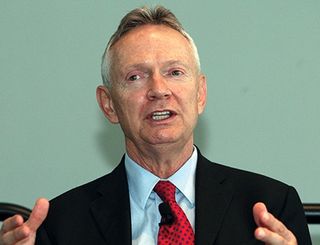FCC: Nielsen DMAs Still Best Definition of TV Markets

Related: NCTA Advises Waiting to Regulate The Internet of Things
The Federal Communications Commission has concluded that Nielsen’s designated market areas (DMAs) remain the best way of defining local TV markets, including citing online video as a way to resolve problems in so-called “orphan” counties served by a station or stations from another state.
In the STELA bill, the commission was directed to study whether there was a better way to define markets than the DMAs, given that some Nielsen markets cross state lines and can result in viewers getting local news from another state rather than their own, or another college football team than their own home team. The bill reauthorized the satellite distant signal license, which allows the importation of affiliated TV station signals to markets that lack them.
Not surprisingly, legislators have gotten complaints over the years from sports fans, and have complained themselves. But the major network affiliate groups told the FCC that there was no good alternative, and pointed out that DirecTV had said it would be unable to adjust its system to a move away from DMAs to some other regime given that it uses spot beams, which it could only adjust slightly. And one ugly consequence—changing from the DMA system would render billions of dollars in satellites essentially useless. The FCC cited that assertion in deciding not to change.
Congress tasked the FCC 18 months ago in the last STELA reauthorization to study possible alternatives. The commission has since concluded that they have not found “a technologically and economically feasible alternative to the current Nielsen DMA system, particularly given that that most recent update allowed for more easy modifications in the case of those cross-border markets.
The FCC said that its analysis also showed that 99.98% of U.S. households could receive at least one in-state station via either an antenna or a multichannel video programming distributor.
Given the current record, the FCC said, “departing from the existing Nielsen DMA market determination system would create enormous disruptions in the video programming industry disproportionate to any benefit gained, and would be unlikely to increase the amount of local programming available to viewers as a whole.”
Broadcasting & Cable Newsletter
The smarter way to stay on top of broadcasting and cable industry. Sign up below
Tangled Web
One takeaway from the report is that the FCC could take steps to encourage broadcasters to make more of their content available online, a point broadcasters were making in arguing for keeping the DMA system.
The National Association of Broadcasters had told the FCC that websites of in-state stations can boost localism in counties served by out-of-state DMAs.
According to the Radio-Television Digital News Association, every TV station that does local news has a website that features the reports, and that 70% of the stations in the top 100 markets run a live newscast on their site.
“We acknowledge that online access to broadcast television offers a method for consumers to potentially access programming from additional television stations outside their market, including access to programming from in-state stations,” the FCC said in a mandatory report to Congress triggered by STELA.
Noting that the web is “unconstrained” by DMAs or boundaries, Bill Lake, bureau chief of the FCC’s Media Bureau, which issued the report, suggested that rather than remaking DMAs, another approach to boosting localism is to “encourage broadcast television stations to make their local programming available online or through mobile applications if they do not do so already.”
The bureau did not say what form that encouragement might take.
The report also asked the commission to suggest additional ways to boost localism in orphan counties. The FCC offered up one possible solution to importing out-of-market programming, which would limit it to the locally produced, non-duplicative content broadcasters have no trouble with—namely, importing duplicative fare that dilutes the local content that broadcasters oppose.
The FCC suggested MVPDs could negotiate for just the local content from several stations and aggregate it on one channel or as a video-on-demand offering, “rather than carrying all of a station’s programming and facing the need to black out all but the relevant, non-duplicative local programming.”
No doubt, the back and forth will continue without blackout.
Contributing editor John Eggerton has been an editor and/or writer on media regulation, legislation and policy for over four decades, including covering the FCC, FTC, Congress, the major media trade associations, and the federal courts. In addition to Multichannel News and Broadcasting + Cable, his work has appeared in Radio World, TV Technology, TV Fax, This Week in Consumer Electronics, Variety and the Encyclopedia Britannica.

